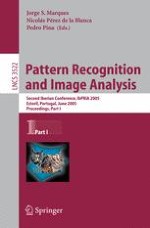IbPRIA 2005 (Iberian Conference on Pattern Recognition and Image Analysis) was the second of a series of conferences jointly organized every two years by the Portuguese and Spanish Associations for Pattern Recognition (APRP, AERFAI), with the support of the International Association for Pattern Recognition (IAPR). This year, IbPRIA was hosted by the Institute for Systems and Robotics and the Geo-systems Center of the Instituto Superior Tecn ´ ico and it was held in Estoril, Por- gal. It provided the opportunity to bring together researchers from all over the world to discuss some of the most recent advances in pattern recognition and all areas of video, image and signal processing. There was a very positive response to the Call for Papers for IbPRIA 2005. We - ceived 292 full papers from 38 countries and 170 were accepted for presentation at the conference. The high quality of the scienti?c program of IbPRIA 2005 was due ?rst to the authors who submitted excellent contributions and second to the dedicated colla- ration of the international Program Committee and the other researchers who reviewed the papers. Each paper was reviewed by two reviewers, in a blind process. We would like to thank all the authors for submitting their contributions and for sharing their - search activities. We are particularly indebted to the Program Committee members and to all the reviewers for their precious evaluations, which permitted us to set up this publication.
